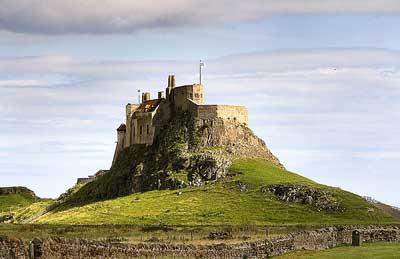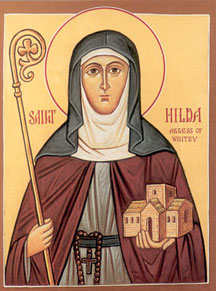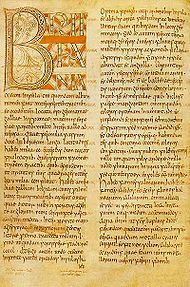 Faith & Worship
Faith & Worship
It is a little bit hazy as to the date when Christianity first made it to Roman Britain. The earliest support for the idea that Christianity arrived in Britain early is Quintus Septimus Florens Terullianus also known simply as Tertullian (AD 155-222) who wrote in "Adversus Judaeos" that Britain had already received and accepted the Gospel in his lifetime. We know that there were bishops there by the 4th century. However, pagan beliefs were strong, and when Anglo-Saxons conquered and colonized the country it left Wales and Cornwall in Romano-Christian possession.
As Anglo-Saxon raids were increasing in England, Ireland was being evangelized by Bishop Palladius, sent by Pope Celestine I in AD431-2 and a Romano-British Christian called Patrick.
Augustine was the prior of a monastery in Rome when Pope Gregory the Great chose him in 595 to lead a mission, usually known as the Gregorian mission, to Britain to convert the pagan King Æthelberht of the Kingdom of Kent to Christianity. Kent was probably chosen because it was near the Christian kingdoms in Gaul and because Æthelberht had married a Christian princess, Bertha, daughter of Charibert I the King of Paris who was expected to exert some influence over her husband. Before reaching Kent the missionaries had considered turning back but Gregory urged them on and, in 597, Augustine landed on the Isle of Thanet and proceeded to Æthelberht's main town of Canterbury.
Gregory intended for Augustine to become the metropolitan archbishop over all of southern Britain, including over the bishops already serving among the Britons.
King Æthelberht converted to Christianity and allowed the missionaries to preach freely, giving them land to found a monastery outside the city walls. Augustine was consecrated bishop of the English and converted many of the king's subjects, including thousands during a mass baptism on Christmas Day in 597. Pope Gregory sent more missionaries in 601, along with encouraging letters and gifts for the churches, although attempts to persuade the native Celtic bishops to submit to Augustine's authority failed. Roman bishops were established at London and Rochester in 604, and a school was founded to train Anglo-Saxon priests and missionaries. Augustine also arranged the consecration of his successor, Laurence of Canterbury. The archbishop died in 604 and was soon revered as a saint.
"Celtic" customs were often seen as conflicting with the Roman customs adopted in most of the Anglo-Saxon kingdoms. The most significant contention was over the Easter dating, which of all the points of disagreement would have produced the most obvious signs of disunity for observers. Under the two systems Easter did not generally coincide, and as such it would be matter of course for Christians following one system to be solemnly observing Lent while others were celebrating the feast of the Resurrection. Indeed, this is noted as occurring in the household of King Oswiu of Northumbria, whose kingdom had been evangelized by both Irish and Roman missionaries. (source Wikipedia)
 In the 6th and
7th centuries it was the monasteries, particularly in Celtic Ireland that
sought to preserve the 'truth' of Christianity. The monastery became the
hub of the community, almost replacing the tribe. As an example, the monastery
at Cionmacnoise was large, centrally cituated and contained many hundreds
of monks. These monks led ascetic lives, often including self-mortification.
They had a great sense of a need for repentance and a thirst for knowledge.
Libraries were established from which were produced illuminated manuscripts.
In the 6th and
7th centuries it was the monasteries, particularly in Celtic Ireland that
sought to preserve the 'truth' of Christianity. The monastery became the
hub of the community, almost replacing the tribe. As an example, the monastery
at Cionmacnoise was large, centrally cituated and contained many hundreds
of monks. These monks led ascetic lives, often including self-mortification.
They had a great sense of a need for repentance and a thirst for knowledge.
Libraries were established from which were produced illuminated manuscripts.
The Irish monastic lifestyle also included missionary travel (seen as an act of penance). In this spirit a monk called Columba (atoning for his part in a family feud) traveled to Iona off the west coast of Scotland and founded a house. From this base, Columba was instumental in the conversion of Picts. Aiden, travelling from Iona assisted the Northumbrian king Oswald in the re-Christianizing of the Northumbrians, a process started by Bishop Paulinus and halted by raids by the pagan king of Mercia.
With the establishment of Monasteries in Angl-Saxon England, centrea of religious thought and leadership were established. Aiden moved to Holy Island at Lindisfarne and led the Northumbrian church, and other Celtic monks converted the East Saxons and the Merciand, and helped with the conversion of East Anglia. An Irish monk called Fursey pressed onward to Gaul (as did Columbanus) founding 2 monasteries and helping to spread the Christians faith into Southern Germany.
According to hagiographies written some centuries later, Illtud and his pupils David, Gildas, Paul Aurelian, Samson and Deiniol from the next generation, were leading figures in sixth-century Britain. Some of them were also active in Brittany. Others who influenced the development of British Christianity include Dubricius, Cadoc, Petroc, Piran, Ia and Kentigern.
The Monastic Rule of St David in the west of Wales prescribed that monks had to pull the plough themselves without draught animals; to drink only water; to eat only bread with salt and herbs; and to spend the evenings in prayer, reading and writing. No personal possessions were allowed: to say "my book" was an offence. David taught his followers to refrain from eating meat or drinking alcohol.
Of all the classic writings that have been handed down to us one of the
most important is the Confession of St. Patrick. This reveals a mind steeped
in the Scriptures, affecting his every thought and action even to the
mundane tasks of everyday life. It also reinforces our view that these
early Christians on the fringes of Britain and Ireland were very much
in touch with the natural world in which they lived.
" ... after I had come to Ireland I daily used to feed cattle,
and I prayed frequently during the day; the love of God and the fear of
Him increased more and more, and the faith became stronger, and the spirit
was stirred; so that in one day I said about a hundred prayers, and in
the night nearly the same; so that I used to remain in the woods and in
the mountains ... "
 The
Synod of Whitby was a seventh century Northumbrian synod where King Oswiu
of Northumbria ruled that his kingdom would calculate Easter and observe
the monastic tonsure according to the customs of Rome, rather than the
customs practised by Iona and its satellite institutions. The synod was
summoned in 664 at Saint Hilda's double monastery of Streonshalh (Streanæshalch),
later called Whitby Abbey.
The
Synod of Whitby was a seventh century Northumbrian synod where King Oswiu
of Northumbria ruled that his kingdom would calculate Easter and observe
the monastic tonsure according to the customs of Rome, rather than the
customs practised by Iona and its satellite institutions. The synod was
summoned in 664 at Saint Hilda's double monastery of Streonshalh (Streanæshalch),
later called Whitby Abbey.
Bishop Colmán argued the Ionan calculation of Easter on the following grounds that it was the practice of Columba, founder of their monastic network and a saint of unquestionable holiness, who himself had followed the tradition of St. John the apostle and evangelist. Wilfrid argued the Roman position on the following grounds (according to Bede's narrative):
1. it was the practice in Rome, where the apostles SS. Peter and Paul
had “lived, taught, suffered, and are buried”;
2. it was the universal practice of the Church, even as far as Egypt;
3. the customs of the apostle John were particular to the needs of his
community and his age and, since then, the Council of Nicaea and established
a different practice;
4. Columba had done the best he could considering his knowledge, and thus
his irregular practice is excusable, but the Ionan monks at present did
not have the excuse of ignorance; and
5. whatever the case, no one has authority over Peter (and thus his successors,
the Bishops of Rome).
Oswiu then asked both sides if they agreed that Peter had been given the keys to the kingdom of heaven by Christ and pronounced to be “the rock” on which the Church would be built, to which they agreed. Oswiu then declared his judgment in favor of the holder of the keys, i.e. the Roman (and Petrine) practice. (source Wikipedia)
References
Green, Vivian: A New History of Christianity, Sutton Publishing Ltd
Various Wikipedia articles (OK, I admit I'm not a proper historian!)

©John Birch · Prayers written by the author may be copied freely for worship. If reproduced elsewhere please acknowledge author/website
Privacy Policy · Links · Author · Donate